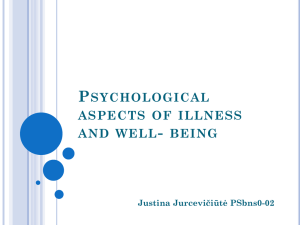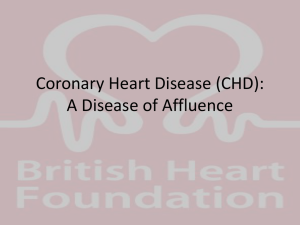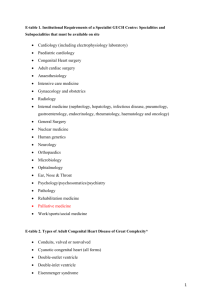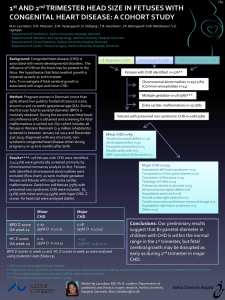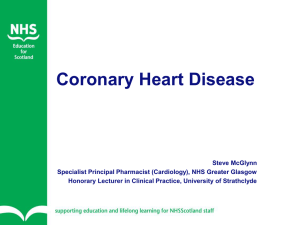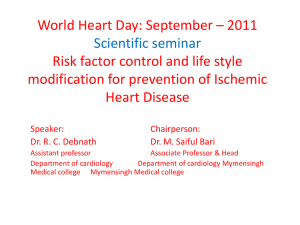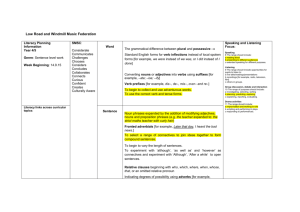EPIDEMIOLOGY OF (CHD)
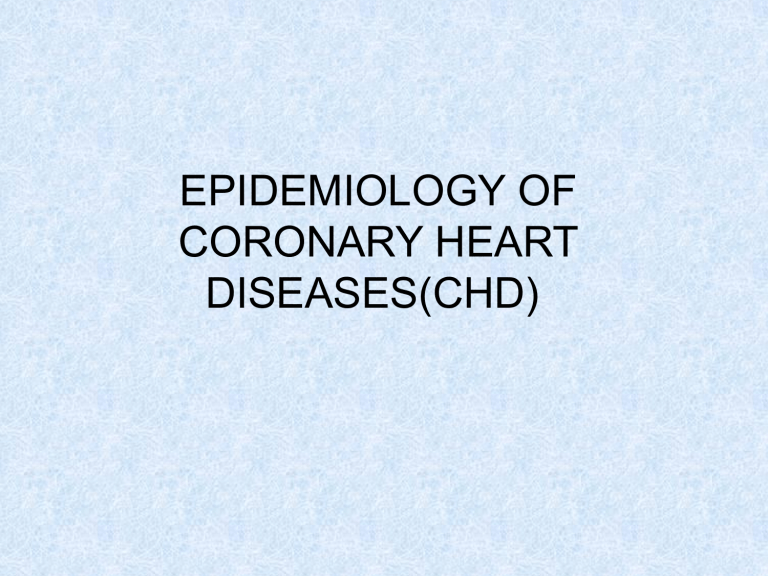
EPIDEMIOLOGY OF
CORONARY HEART
DISEASES(CHD)
The salient epidemiological observations about CHDs are :
• Large population differences in CHD incidence and mortality rates
• Strong correlation between population differences In CHD rate and population differences in mean level and distribution of RFs especially lipids.
• Within population , a strong and continuous correlation between several RFs (S.Ch, BP,
Smoking) and future risk of CHD
• Tracking of CHD RFs among children into adulthood
• Incidence and RFs of CHD in migrants rapidly approached level of adopted population
• Trends in CHD mortality rate , case fatality rate, and incidence occur over very short period (5-10 years)
• The decline in CHD mortality rate seen in industrial countries include all ages, both sexes, and all races
• The above decline is associated with decline in death rate , from stroke, all
CVDs, and non-CVDs
• RCTs found direct effect of decrease in RFs on subsequent disease rate. Prospective studies found that established RFs and associated health behavior can be safely modified
• Epidemiological evidences are consistent with clinical and laboratory findings about causes and mechanism of atherosclerosis , which underlies the manifestation of CHDs
Risk Factors of CHDs
Dyslipidemia
• Hypercholesterolemia is the most specific and the most essential factor
• There is a strong correlation between amount and duration of lowering S.Ch with decreased risk of CHD
• Lowering S.Ch is not associated with increase in mortality from non-CHDs
Dyslipidemia
• LDL-c is a major component of T.Ch, and positively associated with CHD risk. It is affected by changes in diet and weight
• HDL-C is negatively associated with CHD risk. It is affected by exercise, weight, and smoking. It is higher in women
• The role of TG is less consistent. It is positively associated with T.Ch, and negatively with HDL-C level.
Hypertension
• It is a strong RF especially in populations with high prevalence of CHDs
• SBP is better predictor of CHD events than DBP
• Life-style measures are more effective than mass medication in management of mild HT
Cigarette Smoking
• RR is about 2 , higher in young and in population with high prevalence of CHD
• Cessation of smoking is important in primary and secondary prevention of CHDs
• Positive association between CHD risk and amount (but not duration) of smoking
• Passive smoking also increases CHD risk
• The risk is mediated mainly through increased plasma fibrinogen
Smoking Cessation Measures
• Personal advice, smoking cessation clinic, and nicotine withdrawal therapy were tried for smoking cessation with poor results.
• The following were tried for smoking cessation with strong effects:
• Social pressure, prohibition of smoking in public places and work, restricted advertisement, and heavily taxed cigarette trade.
Diabetes Mellitus
• Diabetics have very high risk which is equal in men and women
• It removes the relative protection of premenapausal women
• Insulin resistance is associated with HTG, low HDL-C, and high BP
Obesity
• It increases risk of CHD, stroke, and other
CVDs
• It is associated with DM, HT, high TG, high
TCh, and low HDL-C
• Central obesity is particularly more dangerous
Physical Inactivity
• CHD epidemic is associated with decreased physical activity at work and home
• Physical activity is difficult to be measured
• Exercise can decrease BP, weight , and improves lipid profile
• Even light exercise as walking is beneficial
Other Risk Factors :
• Male Sex : CHD are 2 times more frequent in males
• Positive family history : aggregation of CRFs or increased susceptibility to a particular RF
• Dietary factors : the amount of fat, saturated fat, and cholesterol in the diet increases CHD risk.
High consumption of fish and plant food offer protection
• Natural antioxidants : lipid soluble (vitamin E,
B-carotene) and water soluble (vitamin C, flavonides) decreases CHD risk
• Haemostatic factors:
Hyperfibriniginemia
High coagulation factor VII
Impaired fibrinolytic activity
High PAI-1
• Oral Contraceptives : through:
Increases body weight, BP and PAI-1
Decreases HDL-C level
Altering blood coagulability , platelet function, fibrinolytic activity, and integrity of vascular endothelium
• Alcohol intake : takes J –shape curve with
CHD risk
• Stress and type a personality : Increased sympathetic activity lead to increase catecholamine release, which will increase BP, PR, FFA, increases myocardial O2 demand, deceases O2 supply and alter platelet function
• Socioeconomic status : in developed countries, the association is inverse
In developing countries the association is positive
• Job characteristics : perceived job stress, role ambiguity, job change, unemployment, and retirement
• Hyperuricemia: not established
• Hyperhomocystenemia : easily corrected by folic acid
• Hypercalcemia
• Role of trace elements : exposure to antimony, cobalt, and lead
• Inhalant occupational exposure : carbon disulphide, glyceryl nitric esters
• Water hardness : negative association with CHD risk
• Antiphospholipid antibodies : anticardiolipin, and anticephalothin antibodies
• Infection : Chlamydial pneumonia, dental infection, severe viral illnesses
Manifestations of CHDs
Angina Pectoris
A major cause of disability from 4th decade onward
Subjective diagnosis, with no gold standard
• Rose questionnaire, : low sensitivity , specificity, and positive predictive value
• Resting ECG: not sensitive
• Ambulatory and exercise ECG : expensive
• Radioisotope scan: not practical
• Coronary angiography: not practical
• The more severe and persistent symptoms, the greater the risk of major coronary events
• The greater the number of indicators of myocardial ischemia, the more advanced the disease and the worse prognosis
• Various treatment procedures are palliative rather than curative
• PTCA is cheaper and more palliative than CABG. Both are not better than medical treatment regarding survival
Myocardial Infarction
• 50% of MI cases are either atypical, missed, or misdiagnosed as seen by ECG surveys looking for Q or
QS waves
• The following factors were found to improve survival:
Prevention of VF early in the attack
Initial treatment with aspirin or thrombolytic agents
Long-term treatment with aspirin, B-blockers, and ACE inhibiters
Avoidance of smoking
Rehabilitation programs
Cholesterol lowering treatment
Sudden death
• Definitions are variable from instantaneous death to death within 5 minutes, 1 hour, 3 hour,
12 hour, 24 hour.
• 70% of coronary deaths occurred outside the hospital. This led to:
development of mobile CCU
Para-medical services
population training programs in resuscitation
• 20-40% of potential coronary deaths had no history, symptoms, or autopsy findings of any diagnosis
• Autopsy studies found that sudden death could also be due to pneumonia, valvular heart disease, or alcohol overdose
• 50% of all deaths occurring within 28 days of severe chest pain occur within 2 hours of onset and mostly within very few minutes
Chronic Heart Failure
• It account for small proportion of deaths, but increasing
• Its prevalence is increasing because of increase aging and increase in survival from CHD
• It follows history of MI or myocardial ischemia at many occasions
• Admission for HF increases with increased age, increased number of admissions for other coronary events and with DM
• It is a significant contributor to hospital cost
• ACE inhibiters are beneficial in increasing survival
Inter-relationship of various CHD manifestations
• One type of CHD increases risk of other manifestations
• 20% of CHD victims have sudden death as a first manifestation
• More than 50% of coronary deaths and MI have history of AP or MI
• MI may terminate or initiate AP
• Myocardial ischemia on exercise test after MI indicate high risk of death or re-infarction
• Women have lower rates of sudden death and
MI than men, but have almost similar rates of AP
• Women have lower rates of CHD mortality than men
• A PARADOX: those admitted for coronary emergency without previous history have worse prognosis than those who have positive history
Prevention of CHDs
Primordial Prevention
1. National policies and programs on food and nutrition
2. Comprehensive policies to discourage smoking
3. Programs for prevention of HT
4. Programs to promote regular physical activity
• The strategy is to introduce population wide interventions to lower population levels of smoking, obesity, saturated fat consumption, and salt intake.
• The strategy is to maintain health promoting diet, social and economic conditions which support non-smoking and physically active life-style
Specific actions
1. Tobacco control
• Political commitment and support
• Special emphasis on the control among women, children, and adolescents.
• Effective health education
• Legislations and implementation of these legislations
• Role model by health professionals and school teachers
• Strengthening of cultural and religious values against smoking
Examples of Legislations
• Banning smoking in public places, schools, and health care facilities
• Banning vending machines and selling cigarettes to children
• Banning of tobacco advertisement and promotion
• Preventing new investment in the development of tobacco industry
• Increasing taxation on tobacco product
• Appropriate warning labels
2. Physical Activity
• Activities should be feasible and able to be incorporated into daily life
• Encouraging sports activities at schools and workplace
• Formulation and use of guidelines on physical exercises
• Changing the misconception of both women and community about obesity through health education
3. Nutrition and dietary modification
• It should cover all aspects of food chain from production to consumption
• Multi-sectoral collaboration is essential
(agricultural, trade, industry, education, health)
• Health education and specific legislations are basic components
Dietary Guidelines
• A balanced intake of calories
• A reduced salt content of the diet
• A reduced total saturated fat intake
• A rise in the consumption of fruits and vegetables
• Prevention of unhealthy dietary habits and stopping the cultural invasion of fast food
It is necessary to strengthen the role of the school health curriculum which should cover the knowledge and attitudes needed for CVD prevention
